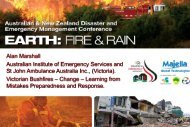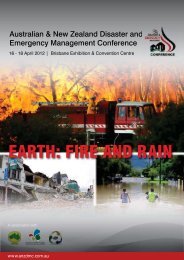Book of Abstracts 2013 - Australian and New Zealand Disaster ...
Book of Abstracts 2013 - Australian and New Zealand Disaster ...
Book of Abstracts 2013 - Australian and New Zealand Disaster ...
You also want an ePaper? Increase the reach of your titles
YUMPU automatically turns print PDFs into web optimized ePapers that Google loves.
disasters always involve a portion <strong>of</strong> unpredicted or unidentified risks. This paper, which is conceptual in nature, looks<br />
at ways <strong>of</strong> preparing to those unforeseen risks to which the population will inevitably be exposed in case <strong>of</strong> a disaster.<br />
This study addresses also the risk that the population might not behave according to predefined emergency<br />
management plans, as it was the case in the Italian cruise ship or in the Fukushima disasters. The integration <strong>of</strong> ad-hoc<br />
traditional approaches <strong>and</strong> systemic methods is stated to be the key to increased community resilience. The former can<br />
give a generally valid framework to behave in case <strong>of</strong> a disaster while the latter can build sustainable resilience. The<br />
theory behind this is that a connected community is more likely to be able to thrive in an environment <strong>of</strong><br />
unpredictability <strong>and</strong> surprise than one in which people do not know each other. For this reason, in a systemic approach,<br />
the population is considered in the network <strong>of</strong> individual members. Starting from the community <strong>and</strong> preceding<br />
towards hazard leaders, this study aims to support disaster preparedness agencies, such as the <strong>Australian</strong> Red Cross<br />
<strong>and</strong> local councils, to h<strong>and</strong>-tailor their approaches depending on the realistic potential <strong>of</strong> the community to apply<br />
disaster preparedness principles.<br />
Dr Chan Kim Chai<br />
Tan Tock Seng Hospital<br />
Key points <strong>of</strong> a hospital business continuity plan for an epidemic: lessons from the SARS <strong>and</strong><br />
H1N1 outbreaks<br />
Having experienced the Severe Acute Respiratory Syndrome (SARS) outbreaks in 2003 <strong>and</strong> the H1N1 flu p<strong>and</strong>emic in<br />
2009, we have identified the following key points that need to be considered, during business continuity planning for a<br />
hospital, in the event <strong>of</strong> an infectious disease outbreak:<br />
(1) Involvement <strong>of</strong> all stack holders both within <strong>and</strong> without the hospital<br />
(2) Have a clear leadership, <strong>and</strong> comm<strong>and</strong> <strong>and</strong> control structure at the hospital, regional <strong>and</strong> national levels<br />
(3) Capacity building:<br />
a. space- plans to exp<strong>and</strong> space for critical hospital operations, or consider the use <strong>of</strong> alternate sites<br />
b. stuff- stockpiles <strong>of</strong> critical medical equipment, personal protective equipment <strong>and</strong> relevant medications;<br />
plans to engage vendors <strong>and</strong> alternate suppliers early<br />
c. staff- training, deployment plan, strategies to cope with manpower shortages, system to ensure staff welfare<br />
<strong>and</strong> well being<br />
(4) Infection control measures: these should be already be implemented during daily hospital operation but can be<br />
ramped up during an outbreak. Important components include security <strong>of</strong> all hospital access points, screening for<br />
infective cases, isolation measures, personal protection for all clinical <strong>and</strong> nonclinical staff, <strong>and</strong> registration processes<br />
to allow for contact tracing.<br />
(5) Access to clinical laboratories with the capability to formulate <strong>and</strong> perform rapid screening tests for emergent<br />
pathogens, 24 hours daily.<br />
(6) Establish channels <strong>of</strong> communication within <strong>and</strong> without the hospital<br />
(7) Consider planning for dedicated transport services for infective cases<br />
(8) Surveillance measures for staff, hospital patients, at the community <strong>and</strong> immigration entry points<br />
Above all, be flexible as each outbreak is unique; plans need to be tweaks in response to the actual ground situations.






